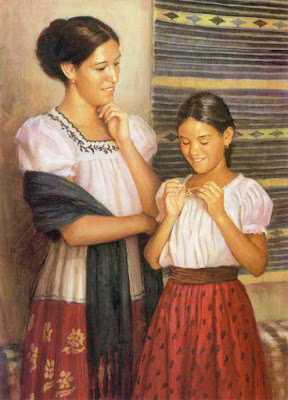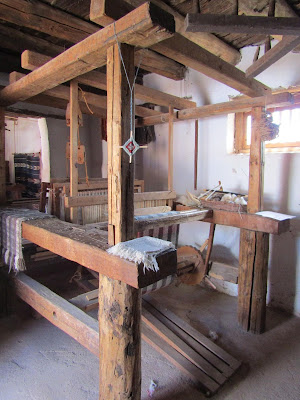El Rancho de Las Golondrinas is a living history museum.
It was an early stagecoach stop on the Camino Real,
It was an early stagecoach stop on the Camino Real,
about 15 miles south of Santa Fe as people traveled
with trade goods up from Mexico during the 19th century.
The property and original buildings were restored and then
reopened in 1972. I have visited this location often when it is open
since the time I have lived in New Mexico.
I photographed Amaya at home with the image in the background
last fall. I love the trees turning color!
One of my early interests in it is that the rancho was used
by American Girl author Valerie Tripp to learn about Josefina
and where her family and culture may have lived.
The property has a collection of historic buildings,
but the main rancho area was where we spent most of our time.
As we entered the rancho, I first stopped by the horno near the gate.
They were burning wood inside of the hornos to heat up the ovens.
People working here took the burning embers out the first oven
and placed the burning embers in the horno next to it.
One woman working the hornos put a few green chiles
on the burning embers to roast the chiles!
I had never seen that!
I had never seen that!
This weekend's theme event is the Spring Festival
and the Fiber Arts, so the focus had to do with the process of
weaving, dying yarn, wool used for yarn, colcha embroidery,
carding and spinning wool into yarn and other aspects
of the early use of wool, yarn, weaving, and textiles.
A few volunteers were working on colcha embroidery
in the courtyard. We went to visit them after watching
the horno ovens being heated for a few minutes.
We visited the adobe rooms inside of the rancho.
Several rooms have looms, yarns,
and woven rugs hanging from the walls.
The room next to one weaving room was next to the torreon.
It had more of a cowboy theme with ropes and gear for horses
It had more of a cowboy theme with ropes and gear for horses
in the room next to the torreon tower.
We looked up the ladder that leads to the torreon tower.
The next room was more of a historic living space.
The next room was a kitchen or food preparation area.
There is a shepherd's bed attached the fire place
There is a shepherd's bed attached the fire place
so that a shepherd can sleep with a young sheep or goat
born early and cold in the spring.
A cradle hangs from the ceiling. Women could tie themselves
to it and rock back and forth as they pounded grains with stones.
After walking through a few rooms,
we went out the kitchen door. It is on the wall
behind the hornos. They had started baking bread in the
horno with the opening closed with a board.
We stopped by a larger loom in another room.
There is an entry between the main rancho from
an earlier time period with the rooms set up in a square
for safety to a later more open adobe.
There is a stall of sheep and goats next to the back wall
of the side rooms.
The later adobe house is called the Baca House.
It was built for the daughter of the original owner
as the time periods changed.
It was built for the daughter of the original owner
as the time periods changed.
In the Baca House, there is a kitchen on one
side and a bedroom on the other side.
I talked a woman weaving out in the open courtyard.
She had a Navajo style loom she described as being a loom
she could transport.
I own the doll Josefina's loom, and despite my mom being a weaver,
my weaving is not as strong. I cannot keep the sides even!
Mine would have to be redone!
(Below is an image, but is not mine.)
Mine would have to be redone!
(Below is an image, but is not mine.)
This below tower is a watch tower. In the Josefina book,
Josefina and her sister climbed up to the second level
to see if her grandfather was coming up the trail in his ox cart.
It was used by people in New Mexico to look for oncoming attacks.
After lunch, we watched a sheep shearer shear a sheep.
He told us that she was a female yearling.
He told us that she was a female yearling.
He used the historic scissors as an example of how
sheep were once sheared.
As a job, he uses the electric clippers.
He let go of the sheep when she was done,
and she ran back into her corral.
He laid out the wool he had clipped off the sheep.
We walked back through the Baca House
courtyard to the main rancho courtyard.
This side of the rancho was once a stall for animals.
It now is more of a reflective chapel with retablo saints
on the walls.
The hornos in the courtyard were cooling down.
They no longer had coals in them and were not baking anything.
One of my photos of Amaya last fall was with her in front of
a photo of the hornos. She was happy to see them in person!
As we got ready to leave, we stopped by a fountain.
We had a lovely adventure today!












































































This is a really cool place to visit! Thanks for sharing!
ReplyDelete